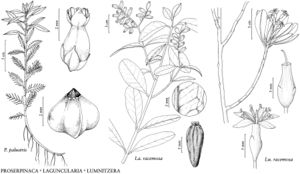Lumnitzera racemosa
Ges. Naturf. Freunde Berlin Neue Schriften 4: 187. 1803.
Shrubs or trees to 6 m (possibly greater). Leaves: petiole poorly developed, 1–7 mm; blade obovate to elliptic, 1.7–9 × 0.6–3 cm, base attenuate or cuneate, margins revolute when young, surrounding shoot apex, surfaces without scattered salt-excretory glands, glabrous [pubescent]. Spikes 1–3[–7] cm. Flowers: sepals 0.8–1.3 mm; stamens 4–5.5 mm; style 4–7.5 mm. Drupes green or brown, 10–20 × 3–8 mm, glabrous [pubescent]. 2n = 24.
Phenology: Flowering spring–summer.
Habitat: Tidal swamps, mangrove communities.
Elevation: 0 m.
Distribution
Introduced; Fla., s Asia (Indochina), e Africa to w Pacific Ocean Islands (Fiji, Tonga), n Australia.
Discussion
In the flora area, Lumnitzera racemosa is known from a single naturalized population in Miami-Dade County.
The open, white flowers of Lumnitzera racemosa are self-compatible and pollinated by bees, butterflies, moths, and wasps. The trees show high fruit set and the fruits, which have a corky outer layer, are water dispersed. The species shows invasive potential; eradication procedures have been attempted, and the cultivated specimens at Fairchild Tropical Botanic Garden have been removed (J. W. Fourqurean et al. 2010).
Selected References
None.
